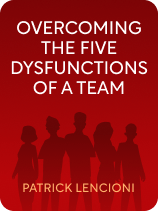
Do your team members feel like they can be completely open with you and each other? Or, do they tend to guard themselves and be careful about what they share?
According to Patrick Lencioni, trust is foundational to team performance. He has written two books about the dysfunctions of teams. The first dysfunction is a lack of trust among team members. He explains what he means by trust, why it’s critical, and how to build it.
Keep reading to learn about team trust.
Patrick Lencioni on Trust
According to Patrick Lencioni, trust is the bedrock of a great team. However, in this case, trust doesn’t mean just trusting your teammates to do their work. It means feeling safe around each other: Teammates who trust each other aren’t afraid to share unusual ideas or admit to their mistakes and worries. Trust means knowing you can share anything (whether business-related or personal) with your teammates—you trust that they won’t use that information to make fun of you, steal your ideas, or harm your reputation.
(Shortform note: A trusting, psychologically safe environment has numerous benefits beyond fostering teamwork. People who trust their coworkers and leaders are generally happier, more engaged, and more productive at work than those who don’t. The benefits even extend to their personal lives—people who work in trusting environments tend to be less stressed and enjoy higher life satisfaction.)
Lencioni argues that distrust is the first and most important dysfunction to surmount because if you and your teammates don’t trust each other, then you can’t operate as a team at all. Without trust, your “team” is actually a group of individuals: people who are more concerned about protecting their interests than tackling the problems they’re supposed to be working together to solve.
For example, suppose an insurance agent accidentally sent an email containing personal information to the wrong client. In an environment of trust, that person would immediately admit the mistake to their teammates, and then the team could work together to minimize the damage; perhaps by having the company pay for identity theft protection services. On the other hand, in a distrusting environment, the insurance agent would just hide their mistake and hope nothing bad happened because of it—protecting their reputation would be more important than addressing the problem.
(Shortform note: One way to build trust is to be open and transparent about everything that you and other team members are doing. If you don’t share everything, it’s easy to unintentionally create an atmosphere of distrust—people are naturally alert for danger, and if they notice something happening that they haven’t been told about, they tend to feel threatened. For instance, if some team members are collaborating on a project that others aren’t involved in (because it’s not relevant to their skills or duties), the ones left out might think it’s a sign that the rest of the team dislikes or distrusts them. You could ease their worries by briefly explaining what those people are working on and why some team members aren’t needed for it.)
How to Build Trust in a Team
Lencioni says that, for teammates to trust each other, they first have to get to know each other. He recommends that you start by having people share relatively safe information about themselves—for example, their favorite book, a personal goal (work-related or otherwise), or a fun childhood memory. This will get them used to talking about themselves and will start forming interpersonal bonds between teammates.
(Shortform note: There are many lists of “icebreaker” questions available to help you start the team-building process. If you already know your team members to an extent, consider looking for questions that suit their personalities such as funny questions or thought-provoking questions.)
Lencioni says you can also strengthen people’s understanding of one another—and therefore their trust in each other—by asking everyone to use a personality profiling tool. Lencioni notes that this will give team members an external, impersonal frame of reference for understanding each other’s behavior. For example, if a test shows that someone has an impulsive personality, their teammates will know not to take it personally if that person interrupts or talks over them.
(Shortform note: Some researchers are skeptical of the accuracy of personality profile tests. In part, that’s because some of these tests haven’t been researched thoroughly enough for experts to reach a scientific consensus about them. Researchers have also observed that people’s behavior can change between one day and the next. This means that you might get totally different results from the same personality test depending on your mood.)
Lencioni warns that while trust is necessary for any team, it can be very difficult to cultivate. This is because trust requires vulnerability: You have to be willing to expose your fears and your weaknesses, which people usually avoid doing at any cost.
To start overcoming that self-preservation instinct, the team leader should be the first to be vulnerable by sharing something uncomfortable or embarrassing—perhaps a mistake they made as a new employee or a time when they made a minor social faux pas. By doing so, they’ll signal to the rest of the team that it’s safe to share things they normally wouldn’t.
| Be Genuinely Vulnerable, Not Manipulative While sharing personal details can be an effective way to form connections and build trust, it’s important to recognize the difference between being vulnerable and oversharing. Vulnerability tends to make people admire and empathize with you while oversharing makes them uncomfortable and pushes them away. As Brené Brown explains in Daring Greatly, the difference often comes down to your intentions: Are you sharing something because you genuinely want the other person to know more about you, or are you trying to force a connection instead of taking the time to let it develop naturally? People also tend to overshare when they’re looking for attention or trying to evoke sympathy; in some cases, they’re trying to manipulate people into giving them a certain response. So, make sure that you’re sharing information out of a genuine desire to form connections with others and not just as a means to some other end (for instance, being the center of attention or getting others to do your bidding). |

———End of Preview———
Like what you just read? Read the rest of the world's best book summary and analysis of Patrick Lencioni's "Overcoming the Five Dysfunctions of a Team" at Shortform.
Here's what you'll find in our full Overcoming the Five Dysfunctions of a Team summary:
- What "teamwork" actually means, and how to foster it
- Why trust is the most important element in an effective team
- The five impairments to teamwork and how to overcome them






